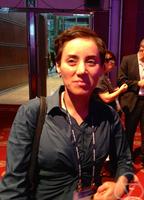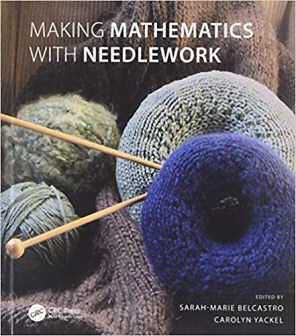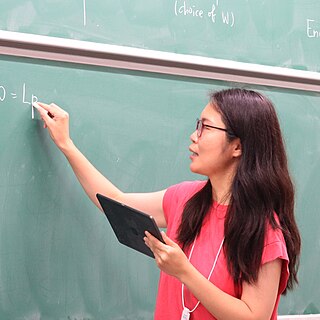
Power in Numbers: The Rebel Women of Mathematics is a book on women in mathematics, by Talithia Williams. It was published in 2018 by Race Point Publishing.

Power in Numbers: The Rebel Women of Mathematics is a book on women in mathematics, by Talithia Williams. It was published in 2018 by Race Point Publishing.
This book is a collection of biographies of 27 women mathematicians, [1] and brief sketches of the lives of many others. [2] It is similar to previous works including Osen's Women in Mathematics (1974), Perl's Math Equals (1978), Henrion's Women in Mathematics (1997), Murray's Women Becoming Mathematicians (2000), Complexities: Women in Mathematics (2005), Green and LaDuke's Pioneering Women in American Mathematics (2009), and Swaby's Headstrong (2015). [1]
The book is divided into three sections. The first two cover mathematics before and after World War II, when women's mathematical contributions to codebreaking and other aspects of the war effort became crucial; [2] together they include the biographies of 11 mathematicians. The final section, on modern (post-1965) mathematics has another 16. [1] Mathematics is interpreted in a broad sense, including people who trained as mathematicians and worked in industry, or who made mathematical contributions in other fields. [3] [4] It includes people from more diverse backgrounds than previous such collections, including 18th-century Chinese astronomer Wang Zhenyi, Native American engineer Mary G. Ross, African-American rocket scientist Annie Easley, [1] Iranian mathematician Maryam Mirzakhani, and Mexican-American mathematician Pamela E. Harris. [5]
The mathematicians discussed in this book include: [1] [2] [5] [6]
The book is aimed at a young audience, [5] with many images and few mathematical details. [3] [5] Nevertheless, each biography is accompanied by a general-audience introduction to the subject's mathematical work, [4] and beyond images of the women profiled, the book includes many mathematical illustrations and historical images that bring to life these contributions. Reviewer Emille Davie Lawrence suggests that the book could also find its way to the coffee tables of professional mathematicians, and spark conversations with guests. [6]
Reviewer Amy Ackerberg-Hastings criticizes the book for overlooking much scholarly work on the subject of women in mathematics, for its lack of detail for some notable women including Émilie du Châtelet and Maria Gaetana Agnesi, and for omitting others such as Mary Somerville. Nevertheless, she recommends it as a "gift book for middle schoolers", as a way of motivating them to work in STEM fields. [1]
Reviewer Allan Stenger notes with approval the book's inclusion of information about how each subject became interested in mathematics, and despite catching some minor errors calls it "a good bet for inspiring bright young women to have an interest in math". [3] Similarly, reviewer L. Angela Mihai writes that it "will educate and encourage many aspiring mathematicians". [2]

The Fields Medal is a prize awarded to two, three, or four mathematicians under 40 years of age at the International Congress of the International Mathematical Union (IMU), a meeting that takes place every four years. The name of the award honours the Canadian mathematician John Charles Fields.

Gabrielle Émilie Le Tonnelier de Breteuil, Marquise du Châtelet was a French natural philosopher and mathematician from the early 1730s until her death due to complications during childbirth in 1749.

Maryam Mirzakhani was an Iranian mathematician and a professor of mathematics at Stanford University. Her research topics included Teichmüller theory, hyperbolic geometry, ergodic theory, and symplectic geometry. On 13 August 2014, Mirzakhani was honored with the Fields Medal, the most prestigious award in mathematics, becoming the first Iranian to be honored with the award and the first of only two women to date. The award committee cited her work in "the dynamics and geometry of Riemann surfaces and their moduli spaces".
Émilie is an opera – specifically a 9-scene, 75-minute monodrama for soprano – by Finnish composer Kaija Saariaho to a libretto by Amin Maalouf. It was written in 2008. Based on the life and writings of Marquise Émilie du Châtelet (1706–1749), the work premiered at the Opéra de Lyon, France, on 1 March 2010, with Finnish soprano Karita Mattila, its dedicatee, in the title role. It recounts the achievements of this mathematician, physicist, and mistress of Voltaire: the first woman to establish an international scientific reputation, with pioneering work in the study of fire.
The Euler Book Prize is an award named after Swiss mathematician and physicist Leonhard Euler (1707-1783) and given annually at the Joint Mathematics Meetings by the Mathematical Association of America to an outstanding book in mathematics that is likely to improve the public view of the field.
Lawrence David Guth is a professor of mathematics at the Massachusetts Institute of Technology.
The Ruth Lyttle Satter Prize in Mathematics, also called the Satter Prize, is one of twenty-one prizes given out by the American Mathematical Society (AMS). It is presented biennially in recognition of an outstanding contribution to mathematics research by a woman in the previous six years. The award was established in 1990 using a donation from Joan Birman, in memory of her sister, Ruth Lyttle Satter, who worked primarily in biological sciences, and was a proponent for equal opportunities for women in science. First awarded in 1991, the award is intended to "honor [Satter's] commitment to research and to encourage women in science". The winner is selected by the council of the AMS, based on the recommendation of a selection committee. The prize is awarded at the Joint Mathematics Meetings during odd numbered years, and has always carried a modest cash reward. Since 2003, the prize has been $5,000, while from 1997 to 2001, the prize came with $1,200, and prior to that it was $4,000. If a joint award is made, the prize money is split between the recipients.
This is a timeline of women in mathematics.

Maria Gaetana Agnesi was an Italian mathematician, philosopher, theologian, and humanitarian. She was the first woman to write a mathematics handbook and the first woman appointed as a mathematics professor at a university.
Talithia D. Williams is an American statistician and mathematician at Harvey Mudd College who researches the spatiotemporal structure of data. She was the first black woman to achieve tenure at Harvey Mudd College. Williams is an advocate for engaging more African Americans in engineering and science.

Giuseppina Masotti Biggiogero was an Italian mathematician and historian. Known for her work in algebraic geometry, she also wrote noted histories of mathematicians, like Maria Gaetana Agnesi and Luca Pacioli. She was a member of the Lombard Institute Academy of Science and Letters and won both the Bordoni Prize and Torelli Prize for her work.
Robyn Arianrhod is an Australian historian of science known for her works on the predecessors to Albert Einstein, on Émilie du Châtelet and Mary Somerville, and on Thomas Harriot.
Women in Mathematics is a book on women in mathematics. It was written by Lynn M. Osen, and published by the MIT Press in 1974.
Pioneering Women in American Mathematics: The Pre-1940 PhD's is a book on women in mathematics. It was written by Judy Green and Jeanne LaDuke, based on a long study beginning in 1978, and was published in 2009 by the American Mathematical Society and London Mathematical Society as volume 34 in their joint History of Mathematics series. Unlike many previous works on the topic, it aims at encyclopedic coverage of women in mathematics in the pre-World War II United States, rather than focusing only on the biographies of individual women or on collecting stories of only the most famous women in mathematics. The Basic Library List Committee of the Mathematical Association of America has strongly recommended its inclusion in undergraduate mathematics libraries.

Making Mathematics with Needlework: Ten Papers and Ten Projects is an edited volume on mathematics and fiber arts. It was edited by sarah-marie belcastro and Carolyn Yackel, and published in 2008 by A K Peters, based on a meeting held in 2005 in Atlanta by the American Mathematical Society.
George Paul Csicsery is a Hungarian-American writer and independent filmmaker who has directed 35 films including performance films, dramatic shorts and documentaries. He is best known for his documentaries about mathematicians and mathematical communities.
A Biography of Maria Gaetana Agnesi, an Eighteenth-Century Woman Mathematician: With Translations of Some of Her Work from Italian into English is a biography of Italian mathematician and philosopher Maria Gaetana Agnesi (1718–1799). It was written and translated by Antonella Cupillari, with a foreword by Patricia R. Allaire, and published in 2008 by the Edwin Mellen Press.

Jinyoung Park is a South Korean mathematician at Stanford University working in combinatorics and graph theory. In 2022, she released a preprint containing a 6-page proposed proof of the Kahn–Kalai conjecture with Huy Tuan Pham.

Mathemalchemy is a traveling art installation dedicated to a celebration of the intersection of art and mathematics. It is a collaborative work led by Duke University mathematician Ingrid Daubechies and fiber artist Dominique Ehrmann. The cross-disciplinary team of 24 people, who collectively built the installation during the calendar years 2020 and 2021, includes artists, mathematicians, and craftspeople who employed a wide variety of materials to illustrate, amuse, and educate the public on the wonders, mystery, and beauty of mathematics. Including the core team of 24, about 70 people contributed in some way to the realization of Mathemalchemy.